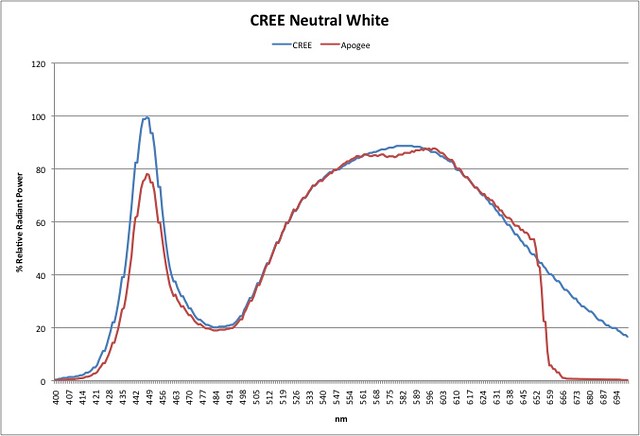if a light source is only providing energy in the form of a wave--and nothing more--then what could the MH/T5's be providing that the LED's are not?
Most likely just different spectral output.
Is it the specific spectral recipe the corals are used to, which would imply that the coral will eventually acclimate to the LED's?
In my experience, yes. At least shallow water corals, to narrow light. However, I think there is more to lack of light, sometimes, I think there is too much light. Corals can produce pigments to protect against light, but not necessarily if they are from an environment that is too deep to get certain spectrums. Danna Riddle, also did some work, and came up with his "red light" hypothesis. That was that certain corals have no protection against red light, because it is mostly filtered out within the first 3 meters of water. So, these deeper water corals are more easily damaged by red. LEDs, don't usually have much red, but the white LEDs (as the graph above shows) can have a lot more green and yellow than most metal halides used in the hobby. Is this a problem? Who knows, everyone keeps regurgitating the line that LEDs have a narrow spectral response LOL (not when your talking about white LEDs, with the exception of violet and some dark red)...
Or is there something other than waves of energy?
Some people think that the direction of light can be a problem. With a light, like a T-5, you get more diffuse light and more of the corals tissue may be exposed to light. So, maybe some of the tissue dies off when under LEDs, as it is no longer illuminated. I guess this decaying tissue could also lead to infections, and weakening of the coral as it adjusts. Although, halides are also pretty directional (but still not as much), so again, tough to say.
[/QUOTE] Is it possible that LED's are providing far more PUR than the corals are used to, which is causing the fading? [/QUOTE]
Maybe, PUR varies by coral though, you can't generalize PUR to all corals, as it depends on the zooxanthellae clade and the zooxanthellae pigments, as well as the corals pigments. This will vary by coral and the same coral can even have different zooxanthellae, sometimes it can even change zooxanthellae.

